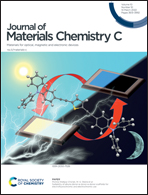Highly efficient thermally activated delayed fluorescence emitters with suppressed energy loss and a fast reverse intersystem crossing process†
Abstract
Thermally activated delayed fluorescence (TADF) emitters with low non-radiative decay and a fast reverse intersystem crossing (RISC) process are highly desirable for achieving efficient organic light-emitting diodes (OLEDs). This work revealed the excited-state structural relaxation induced emission behavior of the frequently used donor unit, spiro[acridine-9,9′-fluorene] (spAc). This structural change at the excited state from bent conformation to planar conformation was suppressed greatly by doping the emitter in a solid matrix, thus avoiding the non-radiative energy loss and enhancing the utilization of excitons. Furthermore, the spAc-based emitters achieved small ΔE(1CT–3CT) and ΔE(3LE–3CT) with the aid of the robust configuration design, thus promoting a fast RISC process up to 1.69 × 106 s−1. As a result, these TADFs demonstrated excellent photoluminescence quantum yields (PLQYs) in the range of 91.0–98.2%. OLEDs based on BPCN-spAc showed a state-of-the-art efficiency with an external quantum efficiency (EQE) of nearly 30% and power efficiency (PE) over 80 lm W−1 at 592 nm. This study deepened the understanding of the luminescent behavior of robust TADF emitters in solution and in the solid state, which could provide helpful guidance for the design of efficient TADF materials.



 Please wait while we load your content...
Please wait while we load your content...